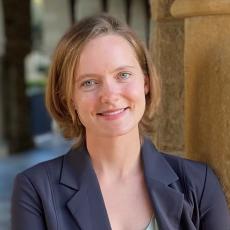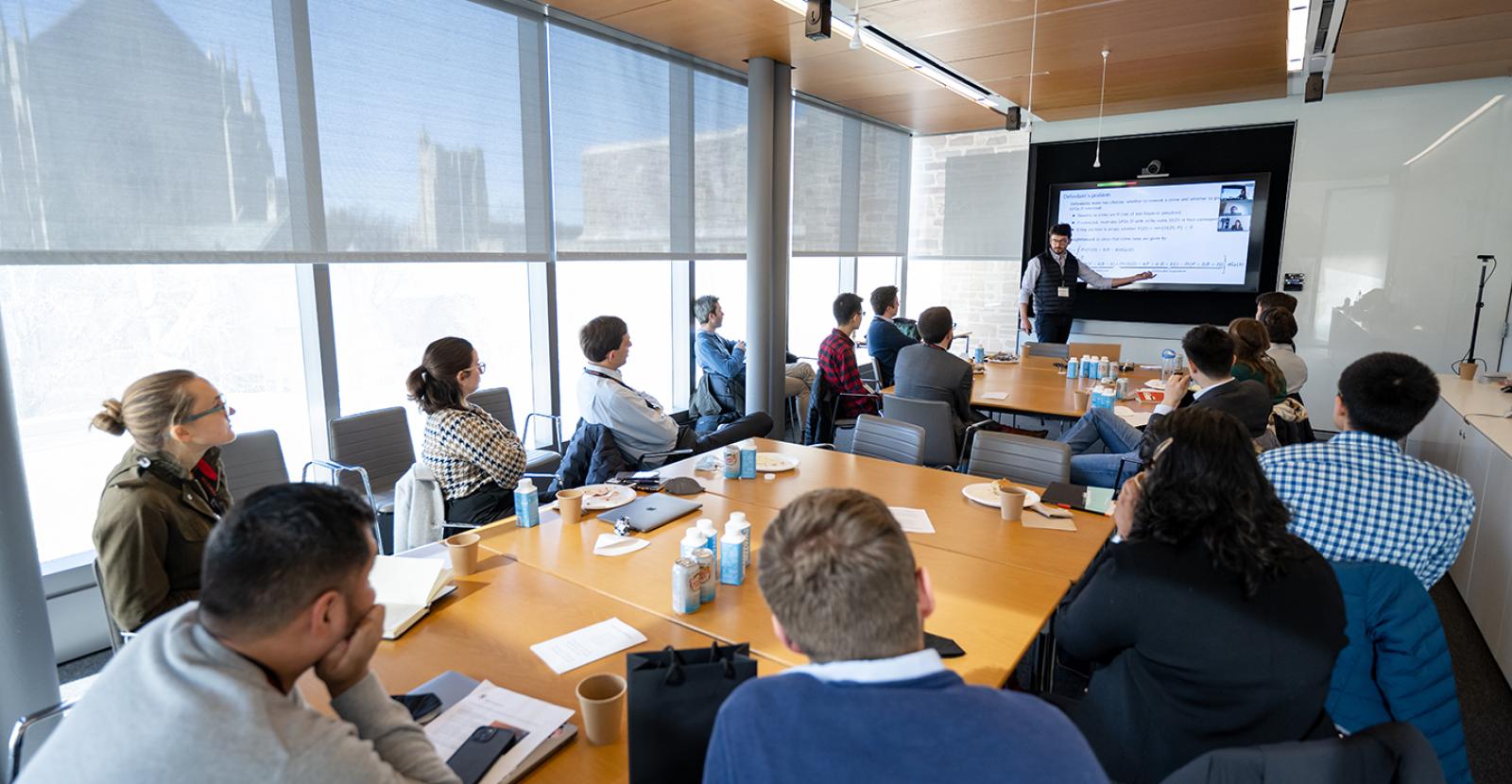| Time | Event | Details |
|---|---|---|
| 08:00am - 09:00am | Breakfast |
Julis Romo Rabinowitz Building, Rm 301 |
| 09:00am - 09:40am | Whom Would You Rather Work With? Uncovering the Referral Gender Gap
Gender I
|
Authors: Livia Alfonsi, Pedro de Souza Ferreira |
| 09:40am - 10:20am | The Effects of Gender Integration on Men: Evidence from the U.S. Military
Gender I
|
Authors: Kyle Greenberg, Melanie Wasserman, Anna Weber |
| 10:20am - 10:40am | BREAK |
|
| 10:40am - 11:20am | The Determinants of Teaching Effectiveness: Evidence from a Model of Teachers’ and Students’ Interactions
Education I
|
Authors: Martin Luccioni Discussant: Olivier De Groote |
| 11:20am - 12:00pm | School Choice and Class-Size Effects: Unintended Consequences of a Targeted Voucher Program
Education I
|
Authors: Olivier De Groote, Ana Gazmuri Discussant: Martin Luccioni |
| 12:00pm - 01:00pm | Lunch |
Julis Romo Rabinowitz Building, Rm 301 |
| 01:00pm - 01:40pm | Officer Heterogeneity
Crime
|
Author: Roman Rivera Discussant: Emma Harrington |
| 01:40pm - 02:20pm | Statistical Discrimination in Sequential Systems: Prosecutors’ Interpretation of Police Arrests
Crime
|
Authors: Emma Harrington, Hannah Shaffer Discussant: Roman Rivera |
| 02:20pm - 02:40pm | BREAK |
|
| 02:40pm - 03:20pm | When do Firms Profit from Wage Setting Power?
Macro-Labor
|
Authors: Justin Bloesch, Birthe Larsen Discussant: Seula Kim |
| 03:20pm - 04:00pm | Workers’ Job Prospects and Young Firm Dynamics
Macro-Labor
|
Authors: Seula Kim Discussant: Justin Bloesch |
| 04:00pm - 04:20pm | BREAK |
|
| 04:20pm - 05:00pm | Quantifying the Role of Firms in Intergenerational Mobility
Intergenerational Mobility
|
Authors: Cauê Dobbin, Tom Zohar Discussant: Carter Braxton |
| 05:00pm - 05:40pm | Intergenerational Mobility and Credit
Intergenerational Mobility
|
Authors: Carter Braxton, Nisha Chikhale, Kyle Herkenhoff, Gordon Phillips Discussant: Caue Dobbin |
| 05:40pm - 07:00pm | BREAK |
| Time | Event | Details |
|---|---|---|
| 08:00am - 09:00am | Breakfast |
Louis A. Simpson International Building, Rm 271 |
| 09:00am - 09:40am | The Gender Pay Gap: Micro Sources and Macro Consequences
Gender II
|
Author: Iacopo Morchio, Christian Moser Discussant: Rachel Schuh |
| 09:40am - 10:20am | Miss-Allocation: The Value of Workplace Gender Composition and Occupational Segregation
Gender II
|
Author: Rachel Schuh Discussant: Christian Moser |
| 10:20am - 10:40am | BREAK |
|
| 10:40am - 11:20am | Company Wage Policy in a Low-Wage Labor Market
Wage Setting
|
Authors: Giulia Giupponi, Stephen Machin Discussant: Jason Sockin |
| 11:20am - 12:00pm | Show Me the Amenity: Are Higher-Paying Firms Better All Around?
Wage Setting
|
Authors: Jason Sockin Discussant: Giulia Giupponi |
| 12:00pm - 01:00pm | Lunch |
Louis A. Simpson International Building, Rm 271 |
| 01:00pm - 01:40pm | Social Interactions and Preferences for Schools: Experimental Evidence from Los Angeles
Education II
|
Authors: Christopher Campos Discussant: Margaux Luflade |
| 01:40pm - 02:20pm | On the Spatial Determinants of Educational Access
Education II
|
Authors: Francesco Agostinelli, Margaux Luflade, Paolo Martellini Discussant: Christopher Campos |

April 4 at 9:00am
Whom Would You Rather Work With? Uncovering the Referral Gender Gap
Livia Alfonsi
Harvard Business School
Speaker Bio:
I am an Assistant Professor at Harvard Business School and a Research Affiliate at CID, LEAP and IZA. I hold a PhD in Agricultural and Resource Economics from UC Berkeley. I study labor markets in low-income settings.

April 4 at 9:40am
The Effects of Gender Integration on Men: Evidence from the U.S. Military
Anna Weber
West Point (US Military Academy)
Abstract
How do men respond when women first enter a historically male occupation? In 2015, the US military removed one of the final explicit occupational barriers to women in the United States by opening all positions to women, including historically male-only combat occupations, providing a unique opportunity to study the initial gender integration of an occupation. We exploit the systematic integration of women into infantry and armor units views using a generalized difference-in-differences approach to estimate the causal effect of the introduction of female colleagues on men’s job performance and satisfaction, using monthly administrative personnel records and rich survey responses measuring organizational climate. We find little evidence that integrating women into previously all-male units negatively impacts men’s performance outcomes, and many of our results are precise enough to rule out large detrimental effects. However, preliminary results suggest that the integration of women into these units leads male soldiers, especially officers, to respond more negatively to questions about their unit’s organizational effectiveness and ability to address potential incidents of sexual harassment.
Speaker Bio:
I am an Assistant Professor of Economics in the Department of Social Sciences and the Office of Economic and Manpower Analysis (OEMA) at West Point. I am an applied microeconomist with a particular focus on labor and public economics. I am particularly interested in the impact of mass incarceration and the role of gender in the labor market. I received my PhD in Economics from Boston University.

April 4 at 10:40am
The Determinants of Teaching Effectiveness: Evidence from a Model of Teachers’ and Students’ Interactions
Martin Luccioni
Olin Business School at Washington University in Saint Louis
Abstract
Standard models of educational production usually treat teachers' contributions to test score growth, commonly referred to as teachers' effectiveness, as invariant across classrooms. However, teachers' effectiveness may be determined by their behavior and interactions with students in the classroom, so teachers' effectiveness may not be a fixed attribute. In this paper, I develop and estimate a model of knowledge production in which teachers choose teaching effort, and students choose learning effort in response. I allow for flexible distributions of students’ initial knowledge, home environments, classroom environments, and teachers’ general teaching skills and effort costs. I estimate the model using the Measures of Effective Teaching Longitudinal Database, which contains multiple measurements of different educational inputs. All else being equal, teachers with high general teaching skills are more effective in classrooms with high initial knowledge. In contrast, teachers with low effort costs are more effective in classrooms with low initial knowledge. In a counterfactual, I assign teachers measured to be highly effective using standard value-added estimates to classrooms with a high proportion of low-achieving students. This counterfactual suggests that the reassigned teachers would be less effective than suggested by their estimated value added. This result is consistent with recent findings suggesting that similar reassignment policy efforts did not achieve their primary goal of promoting low-achieving students' academic performance.
Speaker Bio:
My research interests include the Economics of Education, Labor Economics, Empirical Microeconomics, and Personnel Economics.

April 4 at 11:20am
School Choice and Class-Size Effects: Unintended Consequences of a Targeted Voucher Program
Olivier De Groote
Toulouse School of Economics
Abstract
We propose a novel method to estimate education production functions on observational data in a context of school choice. We exploit panel data of schools and estimate heterogeneous treatment effects, while allowing for unobserved school, student, and teacher characteristics to be correlated with multiple inputs. We then use this model to study the channels behind changes in observed test scores following a voucher reform in Chile. After the reform, many students left public schools, leading to a passive decrease in class size. We show that this can explain part of the policy effects as we find large class size effects for several schools, especially those that saw a decrease after the policy change.
Speaker Bio:
I obtained my PhD from KU Leuven and I am now an assistant professor at the Toulouse School of Economics. My research is on empirical microeconomics, within the fields of labor economics and industrial organization. I work on educational policies (early tracking and choices of school/daycare/college) and environmental policies (solar panel subsidies). For this, I often apply and extend the literature on the estimation of dynamic discrete choice models. I'm visiting the University of Pennsylvania this semester and I'm also traveling to other places in the US.

April 4 at 1:00pm
Officer Heterogeneity
Roman Rivera
UC Berkeley
Abstract
To what extent do individual officers matter in preventing crime, making arrests, committing misconduct, and using force? And are there tradeoffs in the selection of officers due to correlations between their propensities for costly actions, such as force and misconduct, and productive enforcement and crime prevention? This paper studies the degree of officer heterogeneity across enforcement, misconduct, and crime outcomes. I use administrative data from the Chicago Police Department with granular information on officers' shifts, assignments, and activities in combination with crime reports to document a large number of facts about police officer heterogeneity, sorting between assignments, correlations in officer types across outcomes, and the relationship between demographics and both average differences and degrees of heterogeneity.
Speaker Bio:
I am a labor economist studying policing and crime. I am currently a Postdoctoral Scholar at the IRLE at UC Berkeley. Next year, I will be an IRS Postdoctoral Research Associate at Princeton University. In 2025, I will join the McCourt School of Public Policy at Georgetown University as an Assistant Professor.

April 4 at 1:40pm
Statistical Discrimination in Sequential Systems: Prosecutors’ Interpretation of Police Arrests
Emma Harrington
University of Virginia
Abstract
Decision-makers often rely on information that may reflect racial bias in earlier decisions. Do decision-makers adjust for this upstream bias or, instead, passively allow it to turn into systemic discrimination? We model and measure this dynamic using prosecutors’ beliefs about police as a test case. We extend the canonical statistical-discrimination model to allow signals from earlier in the system to be racially biased. We test this model by linking an original survey of North Carolina prosecutors to their court cases. The survey elicits prosecutors’ prior beliefs about racial differences in crime and their perceptions about the informativeness of police reports. We first document the significant variation in prosecutors’ impacts on incarceration disparities (1 SD = 3.6 pp), using the quasi-random of cases to prosecutors. We find that prosecutors’ prior beliefs and perceptions of police reports each explain a substantial share of the variation in prosecutors’ impacts on racial disparities. Indeed, each explains more of the variation in prosecutors’ disparate impacts than prosecutors’ race or politics.
Speaker Bio:
I am an assistant professor at the University of Virginia. I am affiliate of JPAL-North America. I received my PhD in economics at Harvard in 2021, where I was also a Stone Scholar in the Inequality and Social Policy Program. I was a postdoc at Princeton University in the Industrial Relations Section in 2021-2022. I was an Assistant Professor at the University of Iowa Tippie College of Business in 2022-2023. My research focuses on labor, personnel economics, and law and economics. I am particularly interested in remote work and prosecutorial discretion.

April 4 at 2:40pm
When do Firms Profit from Wage Setting Power?
Justin Bloesch
Cornell University
Abstract
In standard models of labor market monopsony, the profits derived from firm monopsony power depends on the firm's labor supply elasticity. There are two puzzles facing these standard models. First, different standard approaches to estimating labor supply elasticities produce dramatically different estimates and hence measures of profits from monopsony power. Second, commonly used low labor supply elasticities imply profit shares of aggregate income that are too high after accounting for price markups and capital income. This paper argues that both of these issues arise from the same limitation - that firms can increase employment only by raising wages. To address this, we develop a tractable model where firms use both higher wages and costly recruiting expenditures to attract workers. Firms have wage setting power due both to search frictions and workers' heterogeneous preferences over workplaces. We show that whether firms profit from their wage setting power depends on the shape of firms' recruiting cost function, and the rents acquired by firms from wage setting power can be dissipated by recruiting costs. In a calibrated quantitative model that also accounts for the strategic behavior of a large firm, profits from wage setting power account for 6% of labor market-wide marginal product and 5% of output. Our findings suggest that wage setting power alone does not imply profits for firms that exploit this power.
Speaker Bio:
I am an Assistant Professor at the Cornell Department of Economics and School Industrial and Labor Relations. My research focuses on labor economics, macroeconomics, and inequality.

April 4 at 3:20pm
Workers’ Job Prospects and Young Firm Dynamics
Seula Kim
Princeton University
Abstract
This paper studies how workers’ uncertain job prospects impact the wages and growth of young firms and quantifies the aggregate implications on productivity and business dynamism. Building a heterogeneous-firm directed search model in which workers gradually learn about permanent firm productivity types, I find that the learning process creates endogenous wage differentials for young firms. In the model, a high-performing young firm must pay a higher wage than that of equally high-performing old firms, while a low-performing young firm offers a lower wage than that of equally low-performing old firms, to attract workers. This is because workers are unsure whether the young firm’s performance reflects its fundamental type or a temporary shock due to the lack of historical records. I find that these wage differentials affect both the hiring and retention margins of young firms and can impede the growth of high-potential young firms. Furthermore, the model indicates that higher uncertainty about young firms leads to bigger wage differentials and thus hampers the overall startup rate, young firm activity, and aggregate productivity. Using employee-employer linked data from the U.S. Census Bureau and regression specifications guided by the model, I provide empirical support for the model predictions. These findings offer a new perspective on entrepreneurship and young firm dynamics through the workers’ job prospects channel, with important implications for business dynamism and aggregate productivity.
Speaker Bio:
I am a Postdoctoral Research Associate in the Louis A. Simpson Center for the Study of Macroeconomics and the Department of Economics at Princeton University in the AY 2023-24. In Fall 2024, I will join the Department of Economics at Penn State University as an Assistant Professor. I received a Ph.D. in Economics from the University of Maryland in 2023.

April 4 at 4:20pm
Quantifying the Role of Firms in Intergenerational Mobility
Cauê Dobbin
Georgetown University
Abstract
We investigate the role of firms in intergenerational mobility by decomposing the intergenerational elasticity of earnings (IGE) into firm-IGE and individual-IGE using a two-way fixed effects framework. Using data from Israel, we find that the firm component is responsible for 22% of the overall IGE. We then explore potential mechanisms and find that education differences explain a large share of the individual-IGE, while place of residence and demographics are more important for the firm-IGE. Guided by these empirical patterns, we develop a novel method to estimate the role of skill-based sorting and find that it accounts for approximately half of the firm-IGE. Our results provide evidence that the intergenerational transmission of earnings encompasses more than just human capital, and highlight the importance of promoting equal access to high-paying firms and reducing labor market segregation in efforts to enhance equality of opportunity.
Speaker Bio:
I am an Assistant Professor at Georgetown University‘s Department of Economics. My main research interests are inequality and the economics of education. I received my Ph.D. from Stanford University.

April 4 at 5:00pm
Intergenerational Mobility and Credit
Carter Braxton
University of Wisconsin
Abstract
We combine the Decennial Census, credit reports, and administrative earnings to create the first panel dataset linking parent's credit access to the labor market outcomes of children in the U.S. We find that a 10% increase in parent's unused revolving credit during their children's adolescence (13 to 18 years old) is associated with 0.28% to 0.37% greater labor earnings of their children during early adulthood (25 to 30 years old). Using these empirical elasticities, we estimate a dynastic, defaultable debt model to examine how the democratization of credit since the 1970s -- modeled as both greater credit limits and more lenient bankruptcy -- affected intergenerational mobility. Surprisingly, we find that the democratization of credit led to less intergenerational mobility and greater inequality. Two offsetting forces underlie this result: (1) greater credit limits raise mobility by facilitating borrowing and investment among low-income households; (2) however, more lenient bankruptcy policy lowers mobility since low-income households dissave, hit their constraints more often, and reduce investments in their children. Quantitatively, the democratization of credit is dominated by more lenient bankruptcy policy and so mobility declines between the 1970s and 2000s.
Speaker Bio:
My name is J. Carter Braxton, and I am an Assistant Professor in Economics at the University of Wisconsin-Madison. My research interests are in macroeconomics, labor economics, and consumer credit.
Visit Carter's website

April 5 at 9:00am
The Gender Pay Gap: Micro Sources and Macro Consequences
Christian Moser
Columbia University
Abstract
Using linked employer-employee data from Brazil, we document a large gender pay gap due to women working at lower-paying employers with better nonpay attributes. To interpret these facts, we develop an equilibrium search model with endogenous firm pay, amenities, and hiring. We provide a constructive proof of identification of all model parameters. The estimated model suggests that amenities are important for both men and women, that compensating differentials explain half of the gender pay gap, and that there are significant output and welfare gains from eliminating gender differences. However, equal-treatment policies fail to achieve those gains.
Speaker Bio:
I am an Assistant Professor within the Economics Division at Columbia Business School and an affiliated faculty member within the Department of Economics at Columbia University. I am also a Research Affiliate at the Center for Economic Policy Research (CEPR) and a Research Fellow at the Institute of Labor Economics (IZA).

April 5 at 9:40am
Miss-Allocation: The Value of Workplace Gender Composition and Occupational Segregation
Rachel Schuh
Federal Reserve Bank of New York
Abstract
This study analyzes whether and how much workers value the gender composition of their workplace and the aggregate consequences of these valuations for occupational segregation, tipping, and welfare. To measure these valuations, I conduct a survey with an embedded hypothetical job choice experiment. From my survey, I estimate that women's valuations for gender composition are homophilic but concave and men value gender diversity. There is significant individual heterogeneity in these valuations: older workers are more likely to value gender homophily, suggesting that as men and women's labor market outcomes have converged over time the value of gender homophily has declined. I then use the survey estimates of gender composition valuations in a structural model of occupation choice to assess their consequences for gender sorting and welfare. I find that if workers did not value gender composition, women's employment in male-dominated jobs would increase substantially, but the estimated gender composition valuations are not large enough to create tipping points in segregation. Gender composition valuations also create a sorting externality: a welfare-maximizing social planner would reallocate workers across occupations to substantially decrease gender segregation.
Speaker Bio:
I am a research economist at the Federal Reserve Bank of New York. My research interests include gender inequality in the labor market and the interplay between innovation, worker outcomes, and firm performance. My current research focuses on understanding the microeconomic causes of gender gaps in the labor market and their consequences for macroeconomic outcomes.
April 5 at 10:40am
Company Wage Policy in a Low-Wage Labor Market
Giulia Giupponi
Bocconi University
Abstract
We study how firms set wages for their employees when they can legally age-discriminate across workers. We exploit an age-specific minimum wage change in the UK, which raised the minimum applying to workers aged 25 and over, leaving unchanged the minima for younger workers. Using matched employer-employee data on a low-paying sector, we show large, positive wage spillovers on workers aged under 25, which arise within firms from company wage policy. Fairness norms offer the most plausible explanation for the emergence of spillovers. The effects that we document also operate in other low-paying sectors of the UK labor market.
Speaker Bio:
I am an Assistant Professor of Public Economics at Bocconi University. I was a Post-doctoral Fellow at the Institute for Fiscal Studies. I received a Ph.D. in Economics from the London School of Economics. My research interests are in the areas of Labor and Public Economics, with a focus on social insurance programs and minimum wage policy.

April 5 at 11:20am
Show Me the Amenity: Are Higher-Paying Firms Better All Around?
Jason Sockin
IZA - Institute of Labor Economics
Abstract
Do firms that pay more offer better amenities, or does the greater pay compensate for worse amenities? Using matched U.S. employee-employer data, this paper estimates the joint distribution of wages, amenities, and job satisfaction across firms. Fifty amenities are captured applying topic modeling to workers' free-response descriptions of their jobs. Three main findings emerge. First, higher-paying firms offer better amenities. Second, employees value amenities: one-third have a more pronounced effect on satisfaction than pay. Third, since workers are willing to pay for satisfaction and because the covariance between amenities and wages is sufficiently high, amenities widen compensation dispersion across firms.
Speaker Bio:
I am currently a postdoctoral scholar with IZA in Berlin and will be joining The ILR School at Cornell University as an Assistant Professor in Fall 2024. My research centers on better understanding how the Internet and technology have fundamentally altered the ways in which workers and firms interact in today's labor market.

April 5 at 1:00pm
Social Interactions and Preferences for Schools: Experimental Evidence from Los Angeles
Christopher Campos
University of Chicago Booth School of Business
Abstract
This paper studies how parents' school choices are affected by information about school and peer quality and how social interactions mediate changes in demand. I design an information intervention that cross-randomizes whether parents receive information about school quality (school value-added) and peer quality. Using a spillover design that varies the saturation of information across schools, I also randomize parents' proximity to other parents with similar information. I find that the information leads to changes in parental preferences toward higher value-added schools, and this occurs when both parents and their neighbors receive information. These results imply substantial information spillovers. I complement this evidence with survey data on the distribution of beliefs over school and peer quality and conclude that the direct and spillover effects of my experiment come primarily from changes in parental preferences rather than an updating of parental beliefs in response to information. These findings show that when parents are informed about school and peer quality, their social interactions lead to changes in preferences in a way that rewards more effective schools. Last, enrollment in more effective schools led to improved socio-emotional outcomes not captured by standardized exams.
Speaker Bio:
I am an Assistant Professor of Economics at the University of Chicago Booth School of Business. I am also a Faculty Research Fellow at the National Bureau of Economic Research (NBER). Before pursuing higher education, I served in the United States Marine Corps and served tours in Iraq and Southeast Asia. I received my PhD in Economics from UC Berkeley in 2021 and spent one year as a Postdoctoral Research Associate with the Industrial Relations Section at Princeton University.

April 5 at 1:40pm
On the Spatial Determinants of Educational Access
Margaux Luflade
University of Pennsylvania
Abstract
We define educational access as the component of a neighborhood's value that is determined by the set of schools available to its residents. This paper studies the extent to which educational access is determined by sorting based on heterogeneous preferences over school attributes, or local institutions that constrain residential location and school choice---such as school catchment areas and housing regulation. We develop a spatial equilibrium model of residential sorting and school choice, estimated using data from a large school district in the United States. The model replicates the responses of house prices and school enrollment to quasi-experimental variation in school peer composition and school transportation provision. We find that low-income families prioritize proximity to schools while high-income families and families with high-skilled children place more value on school peer composition. We use the model to evaluate how the geography of neighborhood sorting influences the aggregate and distributional outcomes of a school-choice expansion (place-based) and a housing voucher (people-based) policy. We find that both policies result in net welfare losses, with only marginal improvements in school peer composition for the average low-income family. Although eligible families benefit from these policies, the negative impact falls on families who currently invest in their children's education by residing in expensive neighborhoods. Under both policies, higher-income families are less exposed to the inflow of low-income children into their schools, either because of their longer distance from target neighborhoods or because of the cost imposed by residential zoning regulation on voucher recipients.
Speaker Bio:
I am an Assistant Professor in the the Department of Economics at the University of Pennsylvania. In 2019-2020, I was on leave at the Becker Friedman Institute at the University of Chicago as a Saieh Family Fellow. My research interests include the fields of Economics of Education, Labor Economics, Applied Microeconomics, and Econometrics.


